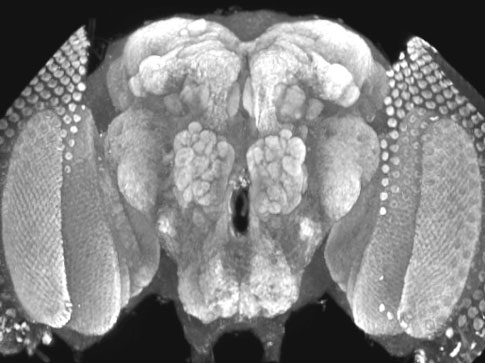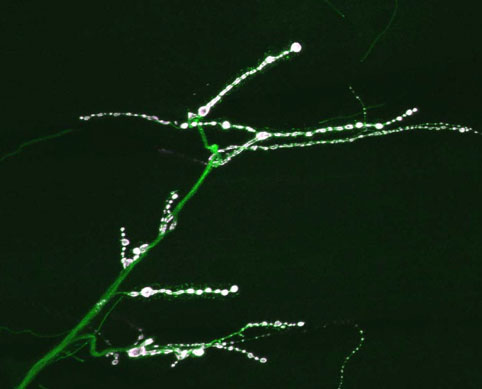 |
|
 |
 |
 |
 |
|
|
Synaptic Plasticity
Axonal sprouting and synaptic rewiring are key
regulators of neuronal plasticity in the developing and adult brain. Similar to
many species, modulation of synapse forma
Ca2+-induced vesicle fusion in presynaptic terminals provides a temporally controlled and spatially restricted signal essential for synaptic communication. Analogous to presynaptic release, postsynaptic vesicles within dendrites have been visualized by TEM, and dendritic release of several neuromodulators has been reported. Recent studies have also shown that postsynaptic vesicles undergo rapid Ca2+-triggered exocytosis that is required for LTP in the mammalian hippocampus. We postulated that postsynaptic vesicle fusion might underlie the Ca2+-dependent release of retrograde signals that triggers altered presynaptic function and synaptic growth at Drosophila NMJs. The synaptic vesicle protein Syt 1 functions as the major Ca2+ sensor for vesicle fusion at presynaptic terminals, but is not localized postsynaptically. Recently, we have found that another isoform of the synaptotagmin family, Syt 4, is present in the postsynaptic compartment (Adolfsen et al., 2004). Mutational analysis of Syt 4 indicates it functions as a postsynaptic Ca2+ sensor to release retrograde signals that stimulate enhanced presynaptic function. In addition to acute changes in presynaptic function, postsynaptic Ca2+ influx also stimulates local synaptic differentiation and growth through Syt 4-mediated retrograde signals that activate the presynaptic cAMP pathway in a synapse specific manner. These findings indicate Ca2+-dependent retrograde vesicular trafficking initiates an acute change in synaptic function that is converted to synapse-specific growth, providing an important link between synaptic plasticity and activity-dependent rewiring of neuronal connections.
The finding that retrograde signaling at synapses is mediated by Ca2+-regulated postsynaptic vesicular fusion represents a shift in the way we think about synaptic information transfer, and we are continuing to characterize the molecular components that regulate postsynaptic vesicle fusion, as well as the retrograde signals involved. Syt 4 expression is bi-directionally regulated by neuronal activity and modulates synaptic growth and plasticity as a function of its postsynaptic levels. Postsynaptic expression of Syt 4 promotes synaptic proliferation and enhanced activity-dependent presynaptic neurotransmitter release, and requires Ca2+ binding by both C2 domains. Syt 4 also contributes to activity-dependent structural plasticity at neuromuscular junctions. Our data indicate that postsynaptic Syt 4 regulates activity-dependent release of postsynaptic retrograde signals that promote synaptic plasticity, similar to the role of Syt 1 as a Ca2+-sensor for presynaptic vesicle fusion.
|
|